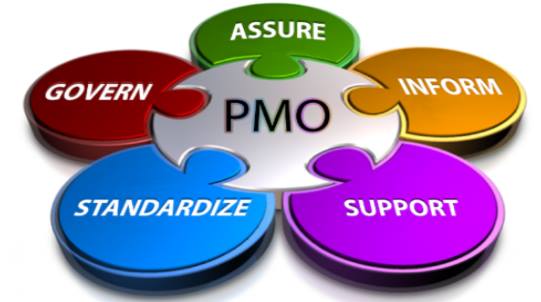Which PMO Structure is Right for Your Organization?
Project management has established dominance in business across various fields. It ensures the delivery of a product or service within a limited budget and in the schedule. Today, project management is an important wing of an organization like accounts, finance, sales, etc.
Introduction to Project Management Office (PMO)

Image Source: https://www.sesc.com/products/9a1auvzcpgseboaw6vdffn3keszinv
Why PMOs?
The implementation of project management methodologies has allowed organizations to produce output efficiently. Project managers are essential to managing projects in an organization.
PMO's have several responsibilities like following processes, managing the project team. They ensure the team produces unique service or product on time and within budget. The need for project managers especially for certified project managers has grown exponentially. Now, in organizations have a department handling the project management activities.
The generic name for this department is “Project Management Office”, abbreviated to PMO. PMO’s body consists of project managers working in a company. Depending on the size of the company, the Project Management Office has to be established. When there are more domains in a company, PMO’s based on specialization or functional areas might be grouped.
For example:
In an automotive company, there are several ongoing projects in each domain. There might be a special PMO for the “Engine” domain, and another special PMO for the “Electrical Component”.
Types of PMO
Generally, there are 3 types of Project Management offices in organizations as described by the Project Management Institute (PMI) in PMBOK 6:
-
Supportive PMO’s
-
Controlling PMO’s
-
Directive PMO’s
Each of these types is suitable for particular organizational structure, we will discuss the same below:
1) Supportive PMO:
Supportive PMO’s act as a repository to your organization’s projects. It supplies templates, best practices, training and keeps track of lessons learned. These have a very low degree of control in projects. You can adopt this if your organization has a functional or weak matrix type.
In functional or weak matrix organizations, project managers have very little control. Functional managers manage virtually all activities, and the budget is under their sole control. Project managers are generally in project expedition or project coordinator roles. They collect, document and store the project activities in the organization’s assets library.
2) Controlling PMO:
Controlling PMO’s act as the auditor of the company. They check whether organizational tools, processes, and standards are applied in projects. They have a moderate degree of control in projects, they are well suited to an organization with a balanced matrix model.
In balanced organizations, project control is shared among functional manager and project manager. They manage the project activities and budget together. Controlling PMO’s check whether the processes, tools, and standards are being applied or not. Corrective actions are taken in case of problem in application or efficiency of processes, tools, and standards.
3) Directive PMO:
As the name suggests, Directive PMO’s manage and have a high degree of control in projects. They are suitable for an organization that is a strong matrix or projection type.
In strong matrix or projectized organizations, the project manager controls the project. The ultimate authority in relation to the project lies with the project manager. Directive PMO’s take complete control of all the projects executed within the organization.
You may also like - Prioritizing project tasks: 6-step process to avoid getting overwhelmed
PMO’s Role in Business –Level Context
As per the Project Business Management framework, there are various PMO roles listed below:
-
Enterprise PMO
-
Division PMO
-
Business Unit PMO
-
Project PMO
-
Project Office
-
Project Support Organization (PSO)
-
Project Management Centre of Excellence (PMCoE)
Let’s discuss the responsibilities, accountabilities & authorities of the Business level PMO’s:
1. Enterprise PMO:
It is a permanent PMO role for an enterprise. The operational responsibilities include strategic master planning and tactical master planning.
They take part in project selection and prioritization. Enterprise PMO’s are authorized to review and approve master projects, portfolio, and budget plans. These PMO’s report to the CEO or the President.
2. Division PMO:
This too is a permanent PMO role for each division, region or portfolio. Their operational responsibilities include tactical master planning and project portfolio management.
They directly report to Division manager or Enterprise PMO. They establish project-portfolio, operational and budget plans, allowing the necessary adjustments when required. They also manage portfolios and oversee programs.
3. Business Unit PMO:
It has a permanent function with one position per business unit. These PMO’s are responsible for operations master planning and project-program management.
They develop project-program operational plans and budget plans and allow changes if any. They manage programs and oversee projects, and report to the division manager.
4. Project PMO:
It has a temporary function with one project PMO for each major or critical project. They are responsible for project initiation, planning, execution, monitoring, controlling and closing. Project PMO’s take the onus of management of a project and are accountable for a specific major project.
They develop project operational plans and budgets and allow adjustments. They manage, control and report project progress; Project PMO’s report to Business Unit PMO.
5. Project Office:
The project office has a temporary function. Their responsibilities include project initiation, planning, execution, monitoring, control, and closing. Sometimes, they also manage projects. The project office is assigned a specific project. It prepares and maintains documentation as per the directions of the project manager.
6. Project Support Organization (PSO):
It is more often than not, a temporary position. They support project initiation, control, planning, execution, monitoring and closing through administrative functions. PSO is accountable for one or more specific projects.
They provide the project control functions. PSO’s report project progress and its status to various project managers or a business unit manager.
7. Project Management Centre of Excellence (PMCoE):
PMCoE generally has a permanent function. It handles establishing, documenting and promoting project business management standards, practices and methods. PMCoE does this while supporting with tools, templates, training and project management competency. It is not assigned to any project but supports a framework to execute projects effectively.
PMCoE maintains, updates and advocates for project business management (PBM) methods, practices, tools, techniques, etc.
It establishes project communications such as:
-
status reports,
-
intranet website, and
-
dashboards.
PMCoE reports to management at the enterprise, division or business unit level as applicable.
You may also like - A sneak-peek into the life of a Project Manager
PMOs in Reality

Image Source: https://www.procurious.com/procurement-news/suppliers-really-think
Out of the above-mentioned PMO functions, Enterprise PMO and Division PMO have a major influence on an enterprise-wide basis. None of the other PMO functions has direct or adequate enterprise-wide influence. For instance, project office, PSO, and PMCoE do not manage the projects; hence, they are not real PMO’s.
Project PMO’s are employed for critical or specific projects. They have little influence on an enterprise-wide basis in the long run.
Business Unit PMO is effective within a business unit. It does not touch upon strategic and tactical aspects outside the sphere of the business unit. Hence, it does not have an influence on an enterprise-wide basis. Moreover, owing to hierarchy, Enterprise PMO is more effective and beneficial for an enterprise in comparison to Division PMO.
Value addition by Enterprise PMO or Division PMO

Image Source: http://www.pinsdaddy.com
With the help of Enterprise or Division level PMO, we can observe following benefits:
-
Advance the enterprise’s project management maturity.
-
Advance the enterprise’s talent capability.
-
Advance the PMO organizational management maturity.
-
Perform the right projects at the right time.
-
Improve efficiency of operational functions.
-
Improve strategic and competitive business advantage.
-
Provide a structured and well-coordinated approach for all the projects, project-programs and project-portfolios.
-
Improve business results from completed projects and accomplished business objectives.
-
Manage organizational transformation of processes and systems.
-
Improve collaborative efforts and integration across operations organizations within the enterprise.
-
Staff complex projects and programs with skilled project professionals.
-
Reduce project and program cost while improving staff productivity.
-
Provide direction for improvement with leadership.
-
Support dissemination of company-wide project management best practices.
-
Lead by example, by continuously improving competency.
-
Provide project/program tracking, reporting, and strategic resources prioritization.
-
Effectively manage and deliver projects on time and within scope.
-
Improve and warrant the enterprise’s market position to win larger projects.
-
Improve assurance of, and enterprise’s reputation for successful projects.
-
Increase market’s (customer’s) confidence in enterprise’s ability to deliver.
-
Lead organizational transformation of processes and systems.
-
Establish & maintain project standardization, documentation, and preparation methodologies.
-
Contribute to sales processes by increasing success in producing winning proposals.
-
Make project-program managers, project managers, & team leaders more effective.
-
Establish an integrated PBM (Project Business Management) approach across the enterprise.
-
Make all stakeholders understand their roles in making projects successful.
-
Apply standardized practices & methods. And hence providing improvements in project execution & project completion. Costs reduction; and positive impact on bottom line.
-
Shift reporting style from a focus on vague progress descriptions to objective reporting. The report can include scope, requirements, cost & schedule versus baselines.
-
Develop, track, and report on program-portfolio, project-portfolio, and project key performance indicators.
You may also like - How difficult is it to crack a Project Management interview?
PMO Sustainability Vs Benefits and Value
A sustainable PMO functional organization must be able to identify, measure, and track and prove its value and benefits. To establish and demonstrate its economic worth, PMO should take following necessary business actions:
-
Select, prioritize, and take up only those projects, which are supporting strategic initiatives as well as business objectives.
-
Direct the proper allocation of enterprise-wide funds & resources. Assuring funds & resources are distributed across the enterprise. They are only to those projects that support strategic initiatives & business objectives. Thereby, warranting for those projects from the beginning, the best opportunity to succeed.
-
Identify and map various categories of risk such as technical risk, operational risk and/or project delivery.
-
Focus on and document all identified risks. Establish control strategies and methods for higher level risks.
-
Identify and document all the non-delivering projects. Cancel each non-delivering project or put the project work on hold.
-
Notify and document all changes in business strategy, available budgeted funds, or requirements and establish the effects on projects-in-progress. Then re-prioritize or place on-hold affected projects.
-
Develop and monitor PMO selected key indicators (KPIs). Ensure this for :
each strategic initiative,
each business objective,
each project-portfolio,
each project-program, and
each project of any significance. -
Report on the status, and take necessary corrective action for each PMO selected KPI.
-
Formally and periodically, communicate the measured value and benefits to the management.
-
Establish and maintain PMO support for operations organizations, and also foster inter-organizational collaboration.
Conclusion
Depending on the power and authority given to the PMO in an organization, control degree of the project managers varies in proportion. Also, depending on the authority & power granted to the PMOs in an organization, type of PMOs change as well.
It will be appropriate to adopt supportive PMOs if you work in the projects more at an operational level. This ensures the power and authority to rely on functional managers.
If you want to apply organizational processes, tools, and standards that need to be applied company-wide; then, controlling PMOs might be the police of your organization. They will check whether the rules and standards are applied to all projects.
And finally, if you want the PMO to be the ultimate leader and controller of the projects; then, you need to adopt Directive PMOs.
Deep-dive into PMO with industry experts. Get certified now!